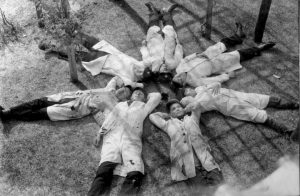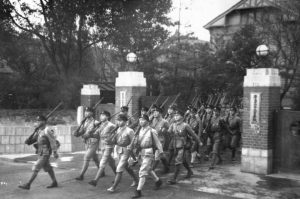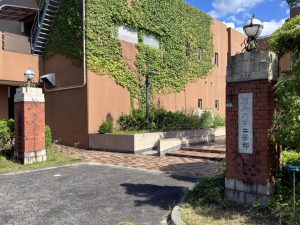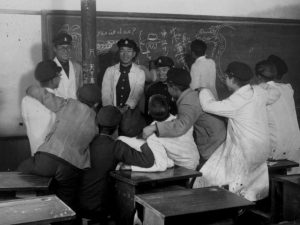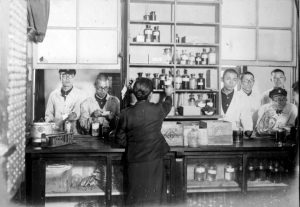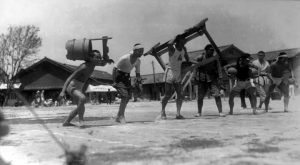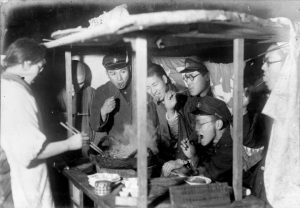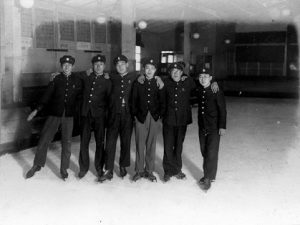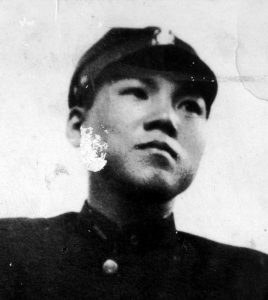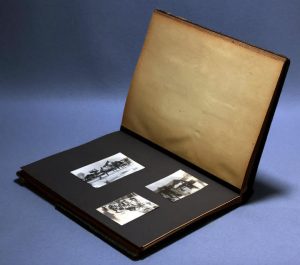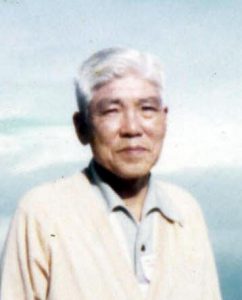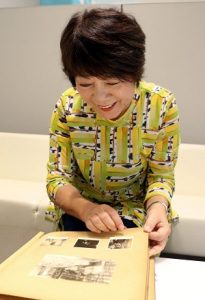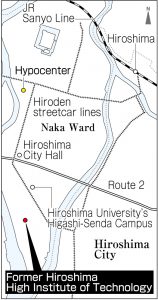Striving to fill voids in Hiroshima — Recreating cityscapes: Bereaved family holds on to graduation album of Hiroshima High Institute of Technology, predecessor to Hiroshima University’s School of Engineering
Jul. 8, 2024
Album with photographs showing students in wartime
Photos of students in white coats, laughing, marching with rifles
by Kana Kobayashi, Staff Writer
On July 1, Hiroshima University marked the 150th anniversary of the founding of its oldest predecessor school. Until the university’s start under Japan’s new post-war education system 75 years ago, there had been several predecessor schools. The Hiroshima High Institute of Technology (present-day Hiroshima University’s School of Engineering) was one of those schools. Hideo Yoshida, who died at the age of 58 in 1980, graduated from the school’s applied chemistry course in 1943. His second daughter, Junko Yoshida, 72, a resident of Hiroshima’s Higashi Ward, has held on to her father’s graduation album. The album shows students fully enjoying their school lives before the atomic bombing, even as the military’s influence heightened amid the Pacific theater of World War II.
In the album, male students in white coats lie on their backs and look up at the sky or laugh and talk in front of a graffiti-covered blackboard. The album consists of four volumes, from a “spring volume” to a “winter volume,” with around 130 photographs depicting school life in the four seasons. The school campus was located in the vicinity of the present-day Senda-machi 3-chome, in Hiroshima’s Naka Ward. “Everyone’s expressions are cheerful. It is the joy of youth,” said Ms. Yoshida as she smiled and turned the album’s pages.
However, the album also contains such photos as one with students walking in formation carrying rifles. The photos mirror the social situation at the time, when marching, shooting, and other forms of combat training had been integrated into the school’s curriculum.
The editors’ note by the album editors, written in September 1943, is carried at the end of the album. It reads, “To friends who have successfully completed academic work and are about to enter a world clouded by war, we hope you were blessed with permanent and noble friendships.” Because of the shortened term of study under the wartime structure, Hideo graduated from the school in September, earlier than the typical graduation in March. In February 1945, he was sent to China as a member of the Army’s 19th independent mixed brigade’s military engineer corps after being called up for training.
On August 6, 1945, the wooden school building of the Hiroshima Technical College, the renamed former Hiroshima High Institute of Technology, collapsed at a location around two kilometers from the hypocenter. Broken window glass and pieces of wood are said to have been scattered about, and voices calling out for help could be heard from throughout the building.
Based on such publications as Hiroshima University’s 25-year History, around one-hundred teachers, staff, and students of the school had died by the end of 1945, The total number of dead from other predecessor schools at the time, including the Hiroshima University of Arts and Science, is considered to have reached at least 682 people.
One-half year after the end of the war, Hideo returned to Japan from Shantou in China’s Fujian Province. The entire area of Hatchobori (now part of Hiroshima’s Naka Ward), where his home was once located, had been turned into a scorched ruins, and his parents and older sister had died in the atomic bombing. While alive, Mr. Yoshida once shared his experience of returning to the city with his wife Masae, who is now 100. “When I arrived at Hiroshima Station and looked in the direction of the Fukuya Department Store (which was located near his home), I saw the ruins. I cried despite being a man,” he said.
However, Junko had never been told by her father about his experience in the war or his sorrow of having lost loved ones. With the album in her hand, she tried to imagine her father’s feelings, which he had not revealed during his life. She added, “Some of the students in the photos likely died in the war or in the atomic bombing.”
The album managed to escape the fires after the bombing because it had been taken from his home in Hatchobori and evacuated elsewhere, along with other household goods, out of concerns about damage from air raids on Hiroshima. According to Masaharu Ishida, an associate professor who works in the editorial office for the Hiroshima University’s 75-year History, the existence in the university of the 1943 graduation album of the Hiroshima High Institute of Technology has not been confirmed. Ms. Yoshida soon plans to donate her father’s album to the Hiroshima University Archives.
Seeking photographs
The Chugoku Shimbun is now seeking photographs taken between around 1930 and August 5, 1945, that depict scenes of Hiroshima and people’s daily lives in the city. Submitted photos and photo albums will be returned after being scanned at the newspaper office. To contact us with any information, please send an e-mail to peacemedia@chugoku-np.co.jp or call 082-235-2801.
For public access, about 1,300 photos of Hiroshima taken before the city was destroyed in the atomic bombing have been positioned on a Google map and are posted on the website “Striving to fill voids in Hiroshima.”
(Originally published on July 8, 2024)

